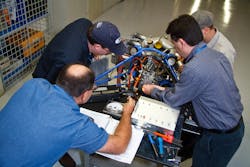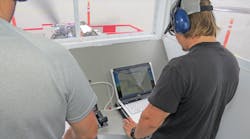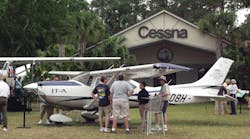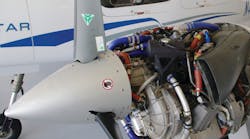Every day, companies like Technify (formerly Thielert) in partnership with Continental; SMA Engines, a division of SAFRAN; and Austro are introducing more diesel engines into aviation around the globe. Continental has shipped more than 4,000 engines (including Thielert military applications). Austro has more than 1,000, and SMA about 50, and growing. How many are actually flying we don’t know, but a number of them are in UAVs. These numbers are pretty small when looking at the total number of aircraft left in the world, but the number is growing and the benefits of this technology will soon make an impression on pilots and operators. Cessna’s J182T will be the start of diesel designed aircraft in the US when the new airplane with the SMA SR305-230E-C1 engine is certified. Piper is aiming at overseas markets, not the U.S., but this should change as the market develops.
Power and efficiency
The draw of a diesel engine is fairly obvious. The engines themselves are rather simple, with their power and efficiency a product simply of the fuel and heat generated by the combustion process. Fuel burn is nearly half that of a typical avgas engine. You change the oil every 100 hours. No carburetor, throttle body, or any of the components necessary for spark ignition are required. Rather, a starter, fuel, oil and coolant pumps are the accessories. A turbo is standard equipment for a diesel engine, for reasons you will see, but this also provides the benefit of sea level and nearly sea level rated horsepower up to 6,000 feet for the CD-155 and 8,000 MSL for the CD-155, with other brands achieving about the same numbers.
The simplicity of the engines, the huge reduction in the amount of fuel burn, and the low demand for unscheduled maintenance will, one of these days, redefine aviation. For now, considering the return on investment, high-use aircraft are the largest market. Schools, pipeline, traffic, and surveillance aircraft are the planes that can see a very quick return on their investment. A diesel installation is not cheap, often being well over $50 to $100K, depending on power. Much of this is the software and electronics necessary to manage the engine, as well as the fuel system. There is no simple throttle any longer; no prop control. And retrofitting requires a lot of modification to airframes and systems, not to forget paperwork. Aircraft designed for diesels and offering them as original equipment are much more economical, but so far, only Diamond Aircraft fits this bill, with a few more (Cessna J182T and Robin) coming to pass in the new future.
While we call them diesels, and we will continue to do so in this piece, the true term for the engine is compression ignition or diesel cycle engines. There are no sparkplugs, no magnetos, electronic ignition modules, harnesses, or timing considerations. The camshaft is similar to avgas engine cams, but the piston is very different. The theory behind diesel engines is simple: Low volatility fuel and air are injected heterogeneously (at different times) at an extremely high psi into a cylinder where the temperature created by the compression of the air alone ignites the fuel.
Diesel development began in the late 1800s when Herbert Akroyd-Stewart began experimenting with paraffin oil as a fuel. This was a thick, non-volatile material that would not vaporize so it was injected directly into the engine. Stewart and Thomas Barton and others continued developing this technology and the first compression ignition engine, with cylinders as we know them built as an experiment. Noted as the father of diesel engines, Rudolf Diesel continued working on the engine after the others went in a different direction. He began obtaining patents in 1892, and his name stuck to the engine.
Today's Diesel Engines
Today’s engines have been vastly refined since then, but the theory is the same. Fuel and air are delivered independently under very high pressure into a cylinder. The air is pressurized via a turbo, the fuel by an engine driven pump. To ensure the complete vaporization of the fuel, the fuel pressure of a typical Continental Diesel CD-135 is just over 19,500 psi. This is not a misprint. The pressure in the fuel rail, a method of delivering the fuel to the cylinder at a high rate and in a very fine spray, requires specialized fittings and plumbing. These high pressures are necessary to overcome the very high compression of the cylinder. Gas aviation engines run from 7:1 to-8.5:1 compression ratios while diesels are in the neighborhood of 18:1, 15:1 for the SMA. The heat created by this sudden and dramatic pressure increase is enough to cause a burn event.
One of the challenges with combustion ignition was cold ambient temperatures. When an engine is sitting on the ground and is cold, the mass of the metals absorb heat from the compression stroke and prevent ignition. Even using the different varieties of Jet fuel, which the airframe companies require, this can be a problem. A glow plug, located in each cylinder, is controlled by a “controller” that comes with every diesel engine, and depending on the temperature internally can be used to create a “hot spot” that aids in vaporization and combustion of the fuel. Cold starts both on the ground and at altitude were a huge consideration at the outset of diesel technology in aircraft. Continental and SMA use the electronically controlled glow plug after starting. Called “post pre-heat," this helps with a quicker warm-up of the engine and is turned off when the engine gets to temperature before flight.
Need for diesel mechanics
Anyone working on a diesel engine must be certified for that particular engine. This is under Part 147, EASA/EC 2042-Part 66, Appendix II. With around 6,000 engines out there so far, mechanics will be needed. Of these aircraft, many are unmanned vehicles that loiter, shoot rockets, or carry cameras for military security and environmental purposes. The United States is the largest potential market for diesel-powered passenger airplanes, but with avgas still available and relatively inexpensive, the market is simply not driving American owners and OEMs to make the transition. Globally, diesel is more immediate, with diesel power being added to designs and retrofitted to aircraft with high accumulations of hours. The drone business is booming internationally. All of them need to be cared for, ensuring a growing need for technicians.
AMT interviewed SMA, Austro Engine, and Continental/Technify Motors executives regarding their engines and training. These are the main players at this point. Each of them has specific items pertinent to their designs. Remember, by nature, the engines are radically different. All three companies hold schools to certify a technician to work on a specific engine. Other companies include Delta Hawk. While all diesel enginess, they are individual designs with specific requirements.
Austro Engines is owned by Diamond Aircraft, and came to be when Diamond decided to become independent of the engine manufacturers. Austro was formed to develop its own adaptation of the Mercedes diesel engine, and has been very successful, designing two aircraft around the engine. Diamond Canada offers diesel schools in London, Ontario, Canada, and in Austria. Their schools require five days/30 hours of training. Since Diamond has recently begun offering owners of their older aircraft the latest AVIC rendition of the Thielert engine, their course requires additional training in Germany for this derivative. Austro is deep into the development of a 300-plus horsepower diesel aimed at larger working aircraft.
SMA engines look similar to gas engines, and they operate at lower rpms not requiring a reduction gearbox. But there is where the similarity ends. All of the special needs of a diesel engine are there and need to be learned. The company offers an online course that is followed by a two-day, hands-on school held in either France, or Fort Worth, TX, at Tarrant Community College (www.smaengines.com/spip.php?rubrique61&lang=en ). SMA is developing a six-cylinder engine that will become a part of this curriculum. SMA offers tool “packages” depending on the needs of the technician: from normal maintenance through more advanced systems servicing. The company continually updates its Instructions for Continued Airworthiness which are available via subscription to ATP.
Continental/Technify holds its training in Mobile, AL. It is a three-day course taught by John Weber, a long-time Thielert representative and now an AVIC guy. The school covers the older Thielert 1.7 engine, and the newer CD-135 and -155 engines. Some of the early technology from SMA’s SR305-230-1 was used to develop Continental’s own new engine, designated the CD-200. This engine will be included in the training syllabus when it goes on line.
Special tools and challenges
Because of the high pressures associated with diesels, specific tools are required and these vary by engine. Basically, the primary tool is a laptop with a data cable and proprietary software that is used for diagnostics, record keeping, and to update the software in the respective system. The engines are so sophisticated and the operational parameters so extreme that every engine is controlled by some sort of brain, or full authority digital engine control (FADEC) system. This precision can only be guaranteed by performing service in a very clean environment. Hangar doors must be tight and dust kept to a minimum.
Continental/Technify has taken steps to allow for more normal conditions. As every state-of-the-art diesel engine, the CD-100 series is controlled by an electronic engine control unit, a redundant system meeting aviation standards like lightning protection. Using a standard laptop and software provided by the engine manufacturer every service center can do fault diagnostics and updates in the field. All electronic connectors are of modern gasketed design which protects the engine against dust and humidity.
As there are no spark plugs, their holes are filed with glow plugs for heating the cylinder mass on cold days. These plugs are small in diameter requiring smaller wrenches and sockets, smaller than normal borescopes, and smaller adapters for compression tests. More advanced tools are available for accessory maintenance.
Techs learning to work on diesels have to become aware of and understand the dangers associated with the high pressures of the fuel, air, and compression. 100,000-psi fuel pressure can be dangerous if a fitting is loose or a line damaged. An air induction hose 3 inches in diameter must be very secure when 100 inch Hg. is being run through it. For these reasons, you do not secure wires, cables, or anything else to any of the plumbing in a diesel engine.
No doubt schools will begin offering compression ignition engine training courses as the engines become more prolific. Except for the SMA engines, you are basically working on a specialized automobile engine built for very sophisticated cars with emphasis on electronics for management. We are fast growing out of the age of pure mechanics to make an engine run well. Should by some chance diesel engines suddenly become more economical to buy and shoehorn into a certified legacy airframe, this industry will boom!








